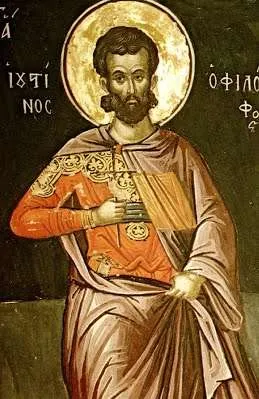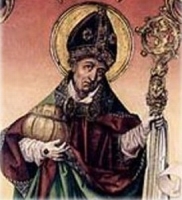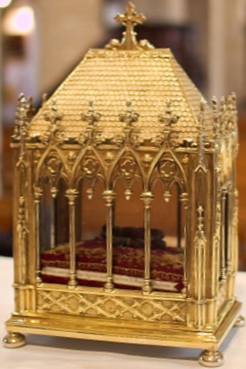c. 291–c. 304; Patron Saint of those seeking chastity and purity, engaged couples, rape victims, gardeners, young girls, and girl scouts; Pre-Congregation canonization
According to one tradition, the daughter of Emperor Constantine the Great—the first emperor to convert to Christianity and legalize its practice—contracted leprosy. Her name was Constantina. Seeking a cure, she approached the tomb of today’s young virgin-martyr and tearfully beseeched her intercession. The tradition further states that Constantina was indeed healed, and, in gratitude, her father commissioned the building of a church over Saint Agnes’ grave. To this day, a church adorns that same spot. To this day, it is named in honor of Saint Agnes. And to this day, the faithful beseech Agnes’ intercession in the same fashion as Constantina in days of old.
Very little is known about Saint Agnes, except for Saint Ambrose’s brief words written many decades after her death. We do know for certain that she was martyred at the age of twelve or thirteen. Later traditions have supplied what history cannot, including what follows.
Agnes was born into a noble Christian family in Rome. She was said to have been quite beautiful, which, together with her wealth and holiness, caused many young noblemen to seek her as their bride. But Agnes’ eyes beheld One Who was the most beautiful of all—her Lord and Savior, Jesus Christ. After taking in His beauty, she could look upon no one else. She dedicated herself to a life of virginity.
Such self-gift, however, was neither well received nor well understood by the young men of her time. Agnes was reported to the local prefect Sempronius for being a Christian, in an attempt to dissuade her from her vow of chastity. The prefect first tried to convince Agnes to offer sacrifice to the Roman gods. She refused. Her heart was firm in its devotion to her Beloved. The prefect then tried to frighten her by displaying some instruments of torture in the hands of the cruel executioner himself. Agnes showed no fear and refused to burn incense to false gods. Outraged, the prefect ordered that she be taken to brothels to be violated by immoral men.
During these ordeals, Agnes knew her Heavenly Spouse would protect her. Evil men could stain their swords with her blood, but they could never profane her body consecrated to Christ. At the brothels, the men looked at her with lust from a distance, but appeared more frightened of her than she was of them. None dared approach her. None dared defile her. It is said that only one young man did approach her, only to be immediately struck blind and brought to the ground. Through a prayer spoken by Agnes, though, his sight was restored.
The prefect, having failed to convert Agnes back to paganism, or to defile her body, then condemned her to a death by beheading. Agnes willingly offered her neck to the executioner, who trembled with fear as he approached, while she was as joyful as a bride waiting to meet her Bridegroom.
Saint Agnes, along with Saint Cecilia, was one of the earliest martyrs whose name was honored by its insertion into the Roman Canon (Eucharistic Prayer I in today’s Mass.) Her name in Latin means “lamb.” As a result, since the sixteenth century, every year on her feast day two lambs are brought to the Roman basilica built over her tomb. Their wool is shorn and weaved into various pallia, vestments covering the shoulders. These very pallia are later placed on the shoulders of archbishops by the pope himself on the Feast of Saints Peter and Paul. Along with his crozier, or staff, the pallium symbolizes a bishop’s role as shepherd.
Source: https://mycatholic.life/saints/saints-of-the-liturgical-year/january-21-st-agnes-virgin-martyr/








